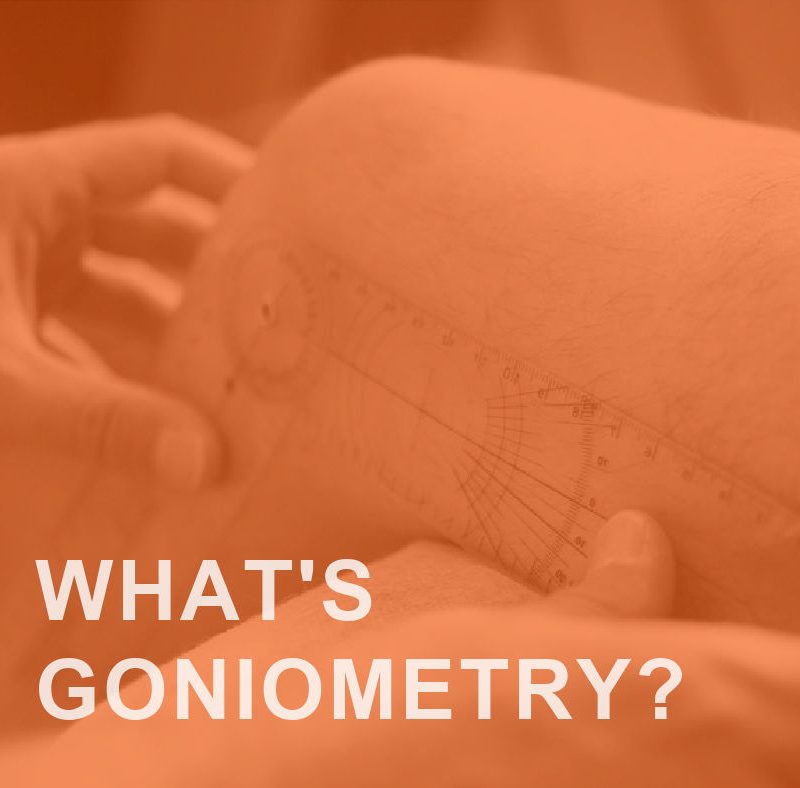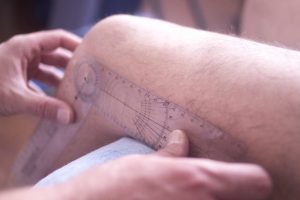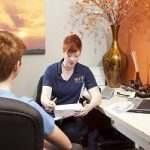
Goniometry is measuring the passive range of motion of a joint using a protractor like device with two arms, called a goniometer, which measures joint angles like a protractor. Why should a personal trainer need to know what goniometry is or how to perform it?
What is goniometry used for?
Most goniometers today are metal or plastic tools with two “arms” and an axis which one arm spins around. The arms are like rulers, able to measure both length and angles in degrees.
Physical therapists are the most likely professionals to utilize goniometry, but in my opinion, every personal trainer would benefit from understanding and utilizing it. Measuring a joint’s range of motion is important for physical therapists when addressing injuries, pain processes, and for seeing the big picture with regard to a patient’s functionality.
How can personal trainers use goniometry?
A personal trainer who might consider using goniometry might do so for some of the same reasons, but also, it can come in handy for determining starting points of joint range of motion during initial assessments and then following up with reassessments, especially when corrective exercise is called for (and almost everyone can benefit from corrective exercise).

I have yet to meet a client who had perfect symmetry or total muscle balance in strength and size, and so at least some corrective exercise is programmed. While minor refinements may not benefit much from goniometry, if you take someone with obvious limited ankle mobility while performing a squat, measuring the client’s range of dorsiflexion will not only give you information about how much restriction is present and how far you need to go, but the client will have concrete measures to look at and gauge improvements.
For example, if you use goniometry to determine that the client’s ankle exhibits a passive range of motion (meaning, you push the foot into dorsiflexion and the client does not use their muscles to initiate the movement) of only 8 degrees, then you know they are restricted since at least 10 degrees is needed for just walking.
Now you can measure active range of motion by having the client do a squat and measure the angle of their ankle while at the bottom of the movement, cueing her to keep the toes and knees perfectly aligned and before knee valgus or foot eversion occurs. If the degree of dorsiflexion in this position is less than 35 degrees, then they are restricted in active dorsiflexion as well. Most clients who are restricted will either fall into knee valgus or foot eversion to compensate for the ankle restriction.
Goniometry procedure
There are recorded optimal range of motions for each joint to use as a reference, and beyond that, the process to perform goniometry is actually pretty simple.
- After determining which joint you want to measure, you choose two bony landmarks to use as a reference point. When measuring hip flexion, for instance, you would have the client lie supine, then align one arm of the goniometer with the pelvis (and torso), place the axis of the tool over the hip joint (the greater trochanter), and align the other arm with the femur.
- The joint should start in a neutral or “zero” position. Use one hand to stabilize the proximal joint component (in this example, the pelvis).
- Now move the joint into the end range of chosen motion. To measure hip flexion, you would bend the knee and move the femur towards the chest. You may also choose to keep the knee straight and measure hip extension as it relates to hamstring extensibility.
- Read and record goniometry angles with the arms of the tool aligned with the chosen bony landmarks.
Considerations
While anyone can safely use goniometry to measure joint angle and determine limited mobility, it is not within a personal trainer’s scope of practice to diagnose any physical disorder. If you suspect a client is suffering from a musculoskeletal issue, immediately refer them out to either their primary care physician or a physical therapist. Beyond that, learning the skill of goniometry is only one more tool to lend credibility and expertise to a personal trainer’s repertoire.
Practice on yourself, family, or friends until you feel comfortable measuring your clients. But most clients will be impressed that you are willing to take their programming to a deeper level by demonstrating your efforts at continuing education in the field of exercise science.








